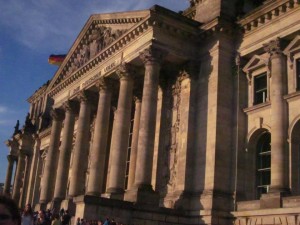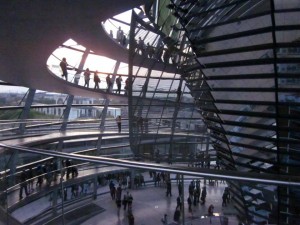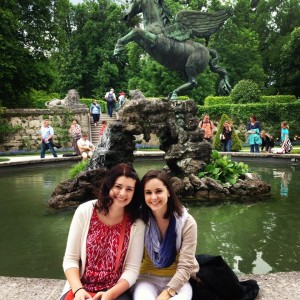by Alexa Blanchard
The International Media class from Point Park University continued its tour of Berlin, Germany, with an evening visit to a government building known as the Reichstag.
The Reichstag building, which has undergone decades of change and reform, initially began as the headquarters of the German empire’s parliament (also called diet or Reichstag) in 1894. According to berlin.de, The Parliament was controlled by several different entities, beginning first with the German empire, followed by the Weimar Republic, and finally in the 1930s fell under Nazi control.
The Nazi Reichstag abandoned the building in 1933 after a devastating fire that destroyed most the building and was never repaired until the fall of the Berlin Wall. Since architect Norman Foster led the reconstruction effort that was completed in 1999, the Reichstag building is used once again as a government entity by the Bundestag, the modern-day term for German parliament.
From the front, the Reichstag building is huge and intimidating with its historical architecture. The pillars and statues keeping watch over the city are reminiscent of the Parthenon of Greece. The building exudes an image of grace and authority over its subjects, powerful to behold. Above the pillars on the architrave is carved a short yet meaningful phrase: Dem Deutschen Volke, or, to the German people.
Attached to the back of the Reichstag building is a massive dome that attracts hundreds of tourists every day. Audio guides are available for use while visitors stroll along the terrace outside of the dome and take in the breathtaking Berlin skyline.
Once inside the dome, the audio guide will begin explaining the history of the building as visitors walk along a ramp that spirals along the edge of the wall to the top of the dome, culminating in a sky view that rests the weary traveler.
The audio guide not only explains the history of the Reichstag building and the dome but also stops the visitor on the ramp to point out several key points of Berlin, such as the television tower. Many of these buildings are historical elements that are related to the Reichstag building, but most are new buildings that had to be built or rebuilt following the devastation of World War II.
The bottom floor of the dome boasts a central element that holds the entire building together. A collection of black and white photographs with detailed captions in several languages are showcased around the middle point of the dome.
These photos outline the integral points of the Reichstag’s history, including the days when it was burned and unusable. Some of the most powerful images were taken during the final days of the Berlin Wall as students sat on top of the Wall in front of the Reichstag while the police force watched them from the ground.
Some of the images are also a bit startling and strange to think about from the perspective now. A photo from 1930 reads: “The NSDPA parliamentary group leaves the auditorium; only Joseph Goebbels remains as an observer.”
So, by this time the Nazi party had taken control. How eerie to still have NSDPA artifacts still on display in a government building. As with many painful things in Germany, the reason for the rebuilt Reichstag and the dome is most likely to serve as reminders to never forget, to never let things get as bad as they once were.
The roof terrace and dome of the Reichstag Building are open from 8 a.m. to midnight daily (last admission: at 10 p.m.) Admission is free, but advance registration is
required. The online registration form can be found at http://visite.bundestag.de. It is closed from Dec. 24-31 and other dates for cleaning. It also closes at times for security reasons when the government is in session.



